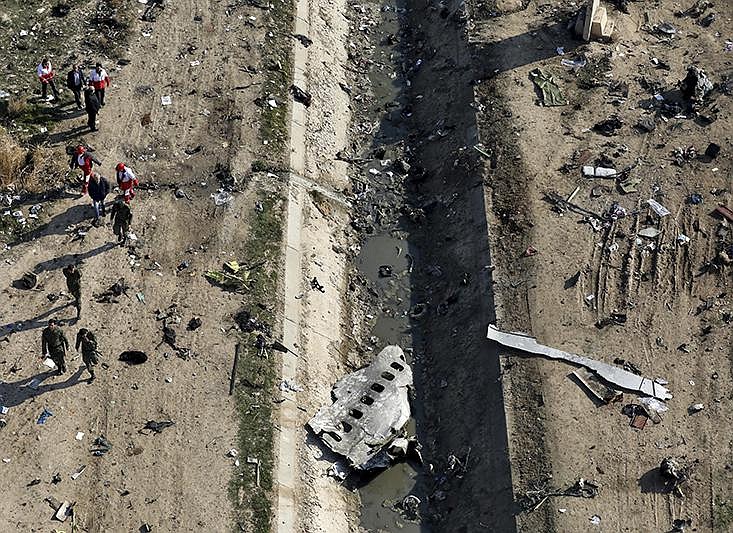BEIRUT -- Iranian investigators blamed the downing of a Ukrainian passenger jet over Tehran earlier this year on the misalignment of an air defense unit's radar system in a report issued late Saturday.
All passengers and crew members -- 176 people -- aboard Ukraine International Airlines Flight 752 were killed in the Jan. 8 crash, which sparked widespread public anger. Iranian authorities took days to admit that its forces had fired an antiaircraft missile at the Boeing 737-800 shortly after its takeoff from Imam Khomeini International Airport.
Most of the dead were Iranian; 85 had citizenship or permanent residence in Canada. Many were students; some were headed to Canada to resume their studies after the holiday break. In the days after the strike, Iranian campuses erupted in protests as grief-stricken and angry youths called for justice.
Canadian officials pressed Sunday for more answers.
"Immediate action is required from the Iranian regime to ensure that they conduct a comprehensive and transparent investigation in accordance with international standards, so that all those responsible are held accountable," said Sylvain Leclerc, a spokesman for Global Affairs Canada.
The report from Iran's civil aviation authority built on earlier findings that blamed the human error of a missile operator who had 10 seconds to decide whether the plane was a threat.
The downing occurred at a time when regional tensions were boiling. A U.S. drone strike killed Iranian Maj. Gen. Qasem Soleimani on Jan. 3, and Iran responded by launching ballistic missiles at U.S. bases in Iraq.
The civil aviation authority claims in the new report that the radar that the missile operator was monitoring had been misaligned, causing it to misinterpret the location of the passenger jet and indicate instead that there might be a second, unidentified, aircraft in the air.
[Video not showing up above? Click here to watch » https://www.youtube.com/watch?v=9M6B8jnGhNQ]
"A failure occurred due to a human error in following the procedure" for aligning the radar, causing a "107-degree error" in the system, the authority reported. It then detailed, minute by minute, the chain of events that led to the plane's targeting. The missile operator contacted higher command but received no response, the authority said. Twenty seconds later, the first of two missiles were fired. Video footage showed the second appearing to hit the aircraft. It erupted in a fireball before crashing on farmland on the outskirts of Tehran.
The report did not include the names of any individuals deemed responsible. The authority argued that this would have hampered the investigators' ability to secure the cooperation of those involved. It said revealing their identities would be decided through the country's judiciary.
Comments attributed to judiciary spokesman Gholamhossein Esmaili by the state-run Islamic Republic News Agency last month suggested that six arrests had been made. Three of the alleged suspects had been let out on bail.
More details of the crash could become clearer later this month. Iran said it would send the aircraft's black boxes -- the flight data recorder and the cockpit voice recorder -- to France by July 20 for examination by experts, the International Civil Aviation Authority said last month. Iran has not followed through on previous promises to turn over the black boxes.
A Canadian readout of a June 22 call between Canadian Foreign Minister Francois Philippe Champagne and Iranian Foreign Minister Mohammad Javad Zarif indicated that Iran had agreed to "enter into negotiations for reparations."
Hamed Esmaeilion lost his wife, Parisa Eghbalian, and their 9-year-old daughter, Reera, in the crash. He said a "full, fair and independent investigation" is far more important than monetary compensation. He was unsatisfied with the new report.
"Iran is trying to manipulate and obstruct justice and hide the truth by shaping public opinion," he told The Washington Post on Sunday. "It's very hard to believe this story."
Esmaeilion, a spokesman for victims' families in Canada, said Iranian officials have sought to intimidate family members, pressuring them to remove social media posts critical of the government.
The Canadian Broadcasting Corp. reported last month that Iran's lead investigator suggested to a victim's family member that the airspace over Tehran wasn't closed on the night of the strike because that might have tipped off U.S. forces on an "imminent" plan to strike their military bases in Iraq. After the CBC sought comment from Iranian authorities, the broadcaster reported, the investigator was removed.
